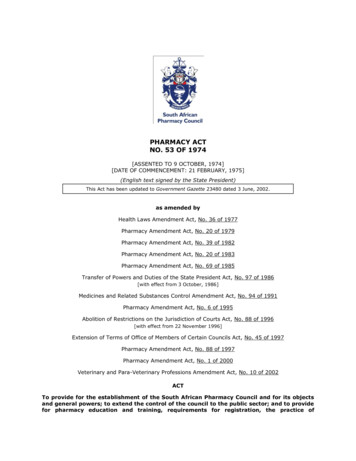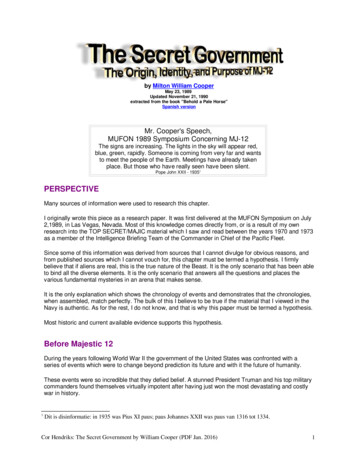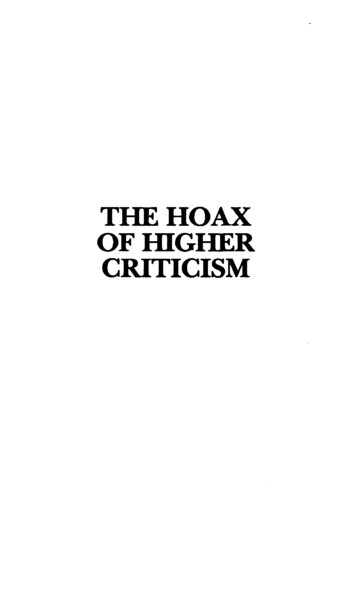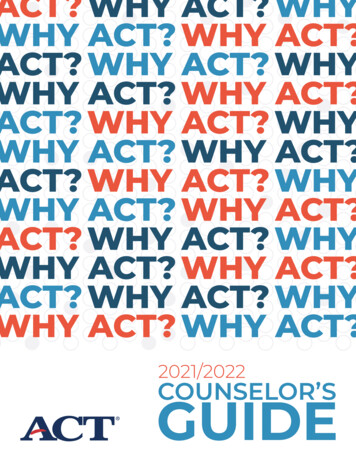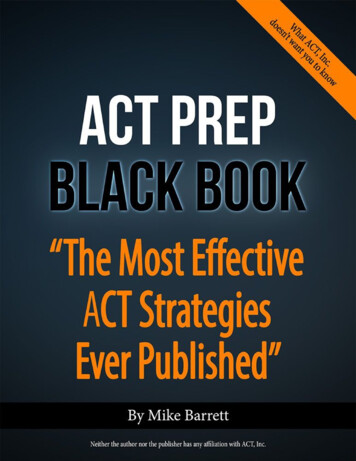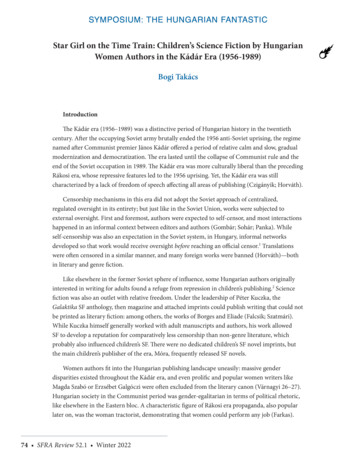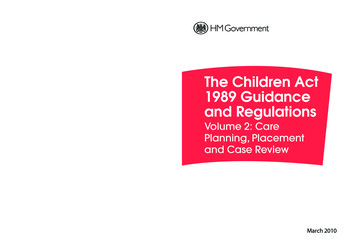
Transcription
Search using ref: DCSF-00185-2010Copies of this publication can be obtained from:DCSF PublicationsPO Box 5050Sherwood ParkAnnesleyNottingham NG15 0DJTel: 0845 60 222 60Fax: 0845 60 333 60Textphone: 0845 60 555 60Please quote the ref: 00185-2010DOM-ENISBN: 978-1-84775-674-9D16(8674)/0310The Children Act 1989 Guidance and Regulations Volume 2: Care Planning, Placement and Case ReviewYou can download this publication atwww.dcsf.gov.ukThe Children Act1989 Guidanceand RegulationsVolume 2: CarePlanning, Placementand Case Review Crown copyright 2010The text in this document (excluding the Royal Arms and other departmental or agencylogos) may be reproduced free of charge in any format or medium providing it is reproducedaccurately and not used in a misleading context.The material must be acknowledged as Crown copyright and the title of the documentspecified. Where we have identified any third party copyright material you will need to obtainpermission from the copyright holders concerned.For any other use of this material please contact the Office of Public Sector Information,Information Policy Team, Kew, Richmond, Surrey TW9 4DU or e-mail: licensing@opsi.gsi.gov.uk.8674-DCSF-CPPR Guidance COVER.indd 1March 201031/03/2010 16:13
Volume 2: Care Planning, Placement and Case ReviewiContentsPreface1Chapter 1. Introduction2SummaryThe Children Act 1989: key principlesPrinciples in relation to children and their familiesThe UN Convention and the European Convention on Human RightsThe child’s wishes and feelingsCorporate parenting and multi-agency involvementThe legal contextThe looked after childDefinitionsOverview of the legislation and regulations in relation to this guidance2234456679Chapter 2. Care planningThe purpose of care planning and reviewPermanence planningThe relationship between the care plan and other plansThe care plan, health plan and personal education planThe care plan and placement planThe care plan and pathway planThe care plan and child protection planThe care planning processThe cycle of assessment, planning, intervention and reviewArrangements for looking after a childThe care plan for a voluntarily accommodated childThe care plan for a child subject to section 31A of the 1989 Act (the Court care plan)Court care plans and adoptionCorporate parenting and Court care plansThe content of the care planCare planning requirements in relation to healthCare planning requirements in relation to educationThe contribution of the corporate parent to educationArrangements for contactWho should be includedSibling contactDifferent types of contactContact arrangements for a child looked after under a care orderContact arrangements for an accommodated 23333
iiThe Children Act 1989 Guidance and RegulationsContact and adoptionThe role of the IRO in improved care planningChapter 3. PlacementPlacement under the 1989 ActThe placement decision for an individual childApplying the individual criteria set out in section 22C (7) to (11)Placements with a person connected to the childAvoidance of disruption in educationPlacements with siblingsAccommodation suitable to the needs of a disabled childPlacements out of the authority’s areaEmergency placements out of areaPlacements outside England and WalesPlacements outside the British IslandsNotificationsTermination of placements by the responsible authorityProvision for different types of placementPlacement of a child in care with parentsPlacements with local authority foster carersTemporary approval of a connected personPlacement in residential carePlacement of a looked after child in ‘other arrangements’Placement plansThe purpose of the placement planTimescales for making the placement planInformation the carer needs in order to look after the childDay to day arrangementsShared responsibilities and consentsPlacement plans for placements back with parentsPlacement planning in short breaksInformation sharingVisits to looked after childrenFrequency of visitsPlacements with a temporarily approved foster carer or a child living with parentsunder an interim care orderA child placed back with parentsA child in care where accommodation is not provided by the responsible authorityAdditional visiting requirementsSeeing the childReports of the visitsConsequences of the visitsConcerns about 066666767687071717273737474747575767677
Volume 2: Care Planning, Placement and Case ReviewAdvice, support and assistance for the childSupervision of the placementRequirements to promote a strategic approach to placementsWhat is meant by ‘sufficiency’What is meany by ‘reasonably practicable’Standard for commissioningIndependent visitorsIdentifying when an independent visitor should be appointedThe role and function of the independent visitorSelecting an independent visitorRecruitmentReview and termination of appointmentExpensesChapter 4. Case reviewPolicy on reviewTiming of reviewsLinks with other reviewsPreparationThe conduct of the reviewConsultation and information gatheringAttendance at the review meetingThe review meeting: matters for considerationUpdating and amending the care planRecord of the reviewDuties of the IRO in the review processAdjournmentsDisagreementsReferral to 9193959596969797Chapter 5. Ceasing to look after a child99Children accommodated under section 20Eligible children – transition to adulthoodFunctions of the personal apter 6. Short breaksThe legal basis for short breaksDeciding which provision is most appropriate for the childWhen a child is not looked afterWhen a child is looked after106106107108108
ivThe Children Act 1989 Guidance and RegulationsCare planning, placement and review in relation to a planned series of short breaksPlanning requirements where regulation 48 appliesVisits where regulation 48 appliesReview requirementsThe role of the independent reviewing officerChapter 7. Case recordsEstablishing the child’s recordRetention and safekeepingAccess and confidentialityElectronic recordsChapter 8. Application of the 2010 Regulations to lookedafter children in contact with youth justice servicesResponsibilitiesLooked after children who have been arrestedLooked after children charged with an offenceChildren not currently looked afterChildren who are remandedLooked after children who are convictedRequirements following sentenceCustodial sentencesResponsibilities of the local authority to looked after children in custodyAssessment of child’s needsAction to be taken if there are concerns about the child’s safety or welfarePlanning and review processSentence planningPlanning for releaseSupport in the 8119119121121122123124125127127128129
Volume 2: Care Planning, Placement and Case ReviewvReferences131Annex 1. The statutory framework for care planning134Annex 2. Overview of the care planning, placement andreview process135Annex 3. Dimensions of developmental need136Annex 4. A model for joint planning and practice143Annex 5. Changes to care status as a result of criminaljustice decisions144Care Planning, Placement and Case Review (England)Regulations 2010146
Volume 2: Care Planning, Placement and Case Review1PrefaceStatusVolume 2 of the Children Act 1989 Guidance and Regulations provides guidance,primarily addressed to local authorities and their staff in England, about theirfunctions under Part 3 of the Children Act 1989. It is issued as guidance undersection 7 of the Local Authority Social Services Act 1970 which requires localauthorities in exercising their social services functions, to act under the generalguidance of the Secretary of State. This guidance should be complied with by localauthorities when exercising these functions, unless local circumstances indicateexceptional reasons that justify a variation.The guidance is addressed to: children’s services social workers; frontline managers who have particular responsibilities in relation to lookedafter children; lead members in local authorities; directors of children’s services; managers of services for looked after children; and commissioners of services for looked after children.It will also be relevant to Children’s Trust partner agencies, and to providers ofservices to looked after children, including private, voluntary and public sectorproviders.Looked after children deserve the best experiences in life, from excellent parentingwhich promotes good health and educational attainment, to a wide range ofopportunities to develop their talents and skills in order to have an enjoyablechildhood and successful adult life. Stable placements, good health and supportduring transition are all essential elements, but children will only achieve theirpotential through the ambition and high expectation of all those involved in theirlives.
2The Children Act 1989 Guidance and RegulationsChapter 1. IntroductionSummary1.1This guidance sets out the functions and responsibilities of local authorities andpartner agencies under Part 3 of the Children Act 1989 (‘the 1989 Act’), whichconcerns the provision of local authority support for children and families. Inparticular it describes how local authorities should carry out their responsibilities inrelation to care planning, placement and case review for looked after children.These responsibilities are designed to support the local authority in its primary dutyset out in section 22(3) of the 1989 Act to safeguard and promote the welfare of thelooked after child and to act as good corporate parents to enable each looked afterchild to achieve his/her full potential in life.1.2This guidance accompanies the Care Planning, Placement and Case Review(England) Regulations 2010 (‘2010 Regulations’), which bring together in a single setof Regulations those duties which are at the heart of effective corporate parentingto improve the outcomes of looked after children, namely:1.3 placing the child at the centre of the work; effective care planning; ensuring that a child or young person is provided with accommodation whichmeets his/her needs; and ensuring that an effective review is conducted of the child’s case within thespecified timescales.This guidance is issued as part of a suite of statutory guidance which, together withthe 2010 Regulations, set out how local authorities should carry out the full range ofresponsibilities in relation to care planning, placement and review for looked afterchildren. Annex 1 shows how these and other documents fit together within anoverall framework, the aim of which is to provide looked after children with themost appropriate placement to meet their needs and improve their outcomes.The Children Act 1989: key principles1.4A key principle of the 1989 Act is that children are best looked after within theirfamilies, with their parents playing a full part in their lives, unless compulsoryintervention in family life is necessary. That principle is reflected in: the concept of parental responsibility;
Volume 2: Care Planning, Placement and Case Review the ability of unmarried fathers to share that responsibility by agreement withthe mother, by joint registration at birth or by court order; the local authority’s functions to provide services which support children andtheir families; the local authority’s duty to return a looked after child to his/her family unlessthis is against his/her interests; and the local authority’s duty, unless it is not reasonably practicable or consistentwith his/her welfare, to endeavour to promote contact between a looked afterchild and his/her parents or others.3Principles in relation to children and their families1.51.6Good social care practice recognises the following principles when working withchildren and their families: Time is a crucial element in work with children and should be reckoned in daysand months rather than years. Parents should be expected and enabled to retain their responsibilities and toremain as closely involved as is consistent with their child’s welfare, even if thatchild cannot live at home either temporarily or permanently. If children have to live apart from their family, both they and their parentsshould be given adequate information and helped to consider alternatives andcontribute to the making of an informed choice about the most appropriateform of care. Continuity of relationships is important and attachments should be respected,sustained and developed. A change of home, carer, social worker or school almost always carries some riskto a child’s development and welfare. All children need to develop their own identity, including self-confidence and asense of self-worth.These principles reflect the intention in the 1989 Act, that parents should beencouraged to exercise their responsibility for their child’s welfare in a constructiveway and that where compulsory intervention in the family is necessary it should,where possible, support rather than undermine the parental role. The 1989 Actplaces a strong emphasis on the local authority working in partnership with parentswhen undertaking their statutory functions.
4The Children Act 1989 Guidance and RegulationsThe UN Convention and the European Convention on HumanRights1.71.8The United Nations Convention on the Rights of the Child (UNCRC) is aninternational human rights treaty to which the UK is a signatory, which grants allchildren and young people aged 17 and under a comprehensive set of rights. Theseinclude the right to: special protection measures and assistance; access to services such as education and health care; develop their personality, abilities and talents to the fullest potential; grow up in an environment of happiness, love and understanding; and be informed about and participate in achieving their rights in an accessible andactive manner.The Human Rights Act 1998 gives further effect in UK law to the rights and freedomscontained in the European Convention on Human Rights (ECHR).The child’s wishes and feelings1.9Section 22(4) of the 1989 Act, consistent with Article 12 of the UNCRC, provides that,before making any decision with respect to a child whom the local authority arelooking after or proposing to look after, the authority must, so far as reasonablypracticable, ascertain the wishes and feelings of the child. Section 22(5) providesthat, in making any decision in relation to the child, it should give due considerationto those wishes and feelings, having regard to the child’s age and understanding.1.10 Children should feel that they are active participants and engaged in the processwhen adults are trying to solve problems and make decisions about them. Whenplans are being made for the child’s future, s/he is likely to feel less fearful if s/heunderstands what is happening and has been listened to from the beginning. Closeinvolvement will make it more likely that s/he feels some ownership of what ishappening and it may help him/her understand the purpose of services or othersupport being provided to him/her, his/her family and carer. Where a child hasdifficulty in expressing his/her wishes and feelings about any decisions being madeabout him/her, consideration must be given to securing the support of an advocate.1.11 There are further practical reasons for ascertaining a child’s wishes and feelingsduring the care planning, placement and review process:
Volume 2: Care Planning, Placement and Case Review5 many children have an understanding of what is causing their problems andwhat underlies their needs; they may have insight into what might or might not work in the context of theircurrent circumstances and environment; they often know what sort of support they would most value and be able toaccess; and engaging children helps to recognise their difficulties, develop their strengthsand promote their resilience.1.12 The child’s views as expressed should always be discussed, recorded and given dueconsideration before a placement decision is made, at every review meeting and atcase conferences. The possibilities and options identified should be explained,discussed and, if necessary, reassessed in the light of the child’s views. The socialworker should be aware of and acknowledge that there may be good reasons whythe child’s views are different from those of his/her parents or the local authority.1.13 The more mature the child, the more fully s/he will be able to enter into discussionabout the plans and proposals and participate in the decision-making process.When older children are involved, and particularly in a case of self-referral, theremay well be a different perception of the child’s needs and interests as seen by thechild and his/her parents. With a young child, the social worker should be creativeand imaginative in finding ways to communicate and discover his/her feelings. Allchildren need to be given information and appropriate explanations so that theyare in a position to develop their own views and make informed choices.Corporate parenting and multi-agency involvement1.14 The responsibility of local authorities in improving outcomes and activelypromoting the life chances of children they look after has become known as‘corporate parenting’ in recognition that the task must be shared by the whole localauthority and partner agencies. The role of the corporate parent is to act as the bestpossible parent for each child they look after and to advocate on his/her behalf tosecure the best possible outcomes.1.15 However, they cannot fulfil this responsibility without the full co-operation andsupport of a range of other agencies which provide services to children and theirfamilies. All partners in the Children’s Trust should share responsibility for narrowingthe outcomes gap for looked after children and Children’s Trust Boards shouldregularly review services for looked after children to ensure that they are effectivelysafeguarded and provided with the opportunities they need. See the statutory
6The Children Act 1989 Guidance and Regulationsguidance on co-operation arrangements, including the Children’s Trust Board andthe Children and Young People’s Plan, for further information.11.16 The Government White Paper Care Matters: Time for Change2 set out an expectationthat every local area should develop a pledge for children in care setting out theirstatutory entitlements and the specific opportunities and support available to them.Looked after children should be involved in developing the pledge which should beregularly reviewed.The legal context1.17 The functions (including powers and duties) of local authorities in relation tochildren who are looked after by them are set out in the 1989 Act as principallyamended by the Children (Leaving Care) Act 2000, the Adoption and Children Act2002 and the Children and Young Persons Act 2008, and the associated Regulationsand guidance in relation to those functions. Section 22(3) of the 1989 Act sets outthe general duty of the local authority looking after a child to safeguard andpromote the welfare of the child. This duty underpins all activity by the localauthority in relation to looked after children.1.18 This guidance is issued as part of a suite of materials which, together with the 2010Regulations, set out how local authorities and their partners should carry out theirfull range of responsibilities in relation to care planning, placement and review forlooked after children. Annex 1 shows how the documents fit together within theoverall framework set out here. Practitioners and managers will need to be familiarwith the primary legislation, the associated Regulations and the statutory guidance.1.19 All the functions of local authorities set out in the primary legislation, Regulationsand guidance, depend on the exercise of professional judgement by social workersand other practitioners, informed by their direct engagement with children andtheir families.The looked after child1.20A child is looked after by a local authority if s/he is in their care by reason of a careorder or is being provided with accommodation under section 20 of the 1989 Actfor more than 24 hours with the agreement of the parents, or of the child if s/he isaged 16 or over (section 22(1) and (2) of the 1989 Act).1.21 For a child who is ‘accommodated’ under a section 20 voluntary arrangement (‘anaccommodated child’), the local authority does not have parental responsibility forthe child – parental responsibility remains with the parents. However, the authoritymust comply with the duties set out in the 1989 Act and with the relevant
Volume 2: Care Planning, Placement and Case Review7Regulations. Although a care order gives the local authority parental responsibilityfor the child, any person who is a parent or guardian also retains their parentalresponsibility and may continue to exercise it to the extent that their actions are notincompatible with the care order (as set out in section 2(8) and section 33(3)(b) ofthe 1989 Act).1.22 Children who are placed away from home under an emergency protection order,where they are accommodated by or on behalf of the local authority, are lookedafter children. So, too, are those children on remand to local authorityaccommodation or under supervision with a residence requirement requiring themto live in local authority accommodation and those children in police protection orarrested and at the police’s request accommodated by the local authority (section21 of the 1989 Act).Definitions1.23 References in this guidance to: ‘the 1989 Act’ are to the Children Act 1989; ‘the 2002 Act’ are to the Adoption and Children Act 2002; ‘the 2010 Regulations’ are to the Care Planning, Placement and Case Review(England) Regulations 2010; ‘the 2002 Regulations’ are to the Fostering Services Regulations 2002; a numbered section or Schedule, are a reference to that section or Schedulein the 1989 Act; a regulation, are a reference to that regulation in the 2010 Regulations unlessotherwise specified; ‘responsible authority’ are to the local authority which looks after the child; ‘area authority’ are to the local authority for the area in which a child is placedor is to be placed, where this is different to the responsible authority; and ‘area’ means the local authority area of the responsible authority.
8The Children Act 1989 Guidance and Regulations1.24 The following terms are also used: ‘IRO’ is the independent reviewing officer for the child; ‘child’ or ‘children’ is used to refer to all children under the age of 18 years(where the context specifically relates to older children, the term ‘young person’is used); an ‘eligible child’ (defined in paragraph 19B of Schedule 2 to the 1989 Act, and inregulation 40 of the 2010 Regulations) is a looked after child aged 16 or 17, whohas been looked after for a total of at least 13 weeks which began after s/hereached the age of 14, and ends after s/he reaches the age of 16; a ‘relevant child’ is a young person aged 16 or 17 who was an ‘eligible child’ butis no longer looked after, defined in section 23A of the 1989 Act and regulation 4of the Children (Leaving Care) (England) Regulations 2001; a ‘former relevant child’, defined in section 23C of the 1989 Act, is a youngperson aged 18 or over who was either an eligible or a relevant child. The localauthority has duties in relation to former relevant children until they reach theage of 21, or 25 in the case of former relevant children who are pursuing aprogramme of education or training; a local authority foster parent, referred to in this guidance as a local authority‘foster carer’, is a person who is approved as a local authority foster parent (itincludes foster carers who have been approved by an independent fosteringagency and foster carers who have been approved by the local authority, as setout in the 2002 Regulations); a ‘carer’ or ‘the child’s carer’ is the person with whom the child is living in fostercare or a registered children’s home; and a ‘parent’ is a person who is the parent of the child, a person who is not thechild’s parent but who has parental responsibility for the child or, where thechild is in care and there was a residence order in force with regard to the childimmediately before the care order was made, a person in whose favour aresidence order was made.1.25 To assist the reader in cross-referencing this text to key sections of the 1989 Act orto the 2010 Regulations, these are signposted in the text as follows:[Schedule or section of the 1989 Act][Part, Schedule or regulation in the 2010 Regulations]
Volume 2: Care Planning, Placement and Case ReviewOverview of the legislation and regulations in relation to thisguidancePrimary legislation1.26 New sections 22A to 22F, inserted into the 1989 Act by the Children and YoungPersons Act 2008, re-enact the duties on local authorities to provideaccommodation for children who are in their care and to maintain all looked afterchildren in other respects, apart from the provision of accommodation. The dutiesand powers of local authorities to provide accommodation under sections 20 and21 of the 1989 Act (i.e. those who are ‘voluntarily accommodated’ oraccommodated for their own protection or by virtue of an order made in criminalproceedings) are unaffected by these new provisions.RegulationsTable 1: Summary of the 2010 RegulationsCare planning4An explicit requirement to prepare a care plan and requirements forwhen the plan must be produced.5–6The content of the care plan, including the requirement to include aplan for permanence (‘permanence plan’), the arrangements to meet thechild’s needs, and the arrangements to keep the care plan under review.7Health care arrangements, including the requirement for a medicalpractitioner to carry out a health assessment, and timescales for this.8Contact arrangements in relation to a child subject to a care order– requirements in relation to the written information that must beprovided by the responsible authority if they refuse to allow contactbetween the child and another person.Placement9Preparation of a placement plan for each child, including timescales.10 – 14Avoidance of disruption in education, placements out of area,written notification of placements (‘notifications’) and termination ofplacements.15 – 20Arrangements for placing a child in care back home with parents,including a placement before the assessment is completed.9
10 The Children Act 1989 Guidance and RegulationsTable 1: Summary of the 2010 Regulations21 – 27Placing a child with a local authority foster carer and in otherarrangements.28 – 31Arrangements for social workers to visit a looked after child includingthe differing frequency requirements depending on the type ofplacement. There is a requirement for advice, support and assistance tobe available in between visits.Review32 – 33Duty and timescales for carrying out reviews, including the statutoryminimum frequency.34 – 36The conduct of the review, including the need to have a written policyon the manner in which reviews are to be conducted, which is to bemade available to the child and family.37 – 38Implementing decisions and recording the outcome of reviews.Ceasing to look after a child39The requirement for a care plan to include services to be in place tosupport an accommodated child who is ceasing to be looked after.40 – 44Arrangements for preparing for an eligible child to leave care.Independent reviewing officers (IROs)45 – 46Details of additional IRO functions, including their role in assisting thechild to obtain legal advice or bring legal proceedings on his/her behalf,in line with the extended remit of IROs in relation to the oversight of achild’s case.Independent visitors47The definition of ‘independent’ in relation to independent visitor (seesection 23ZB of the 1989 Act).Short breaks48Application of the 2010 Regulations to arrangements for short breaks inrecognition of the continuing role of birth parents in safeguarding andpromoting their child’s welfare.Case records49 – 50Details of the requirement to establish and maintain a written caserecord for the child and the retention and confidentiality of the records.
Volume 2: Care Planning, Placement and Case Review11Chapter 2. Care planningThe purpose of care planning and review2.1Care planning and case reviews are about bringing together children who arelooked after, their families, the child’s carers and professionals, in order to plan forthe care of the child and to review that plan on a regular basis. Assessing the needsof children and deciding how best to meet those needs is a fundamental part ofsocial work with looked after children. To do this effectively not only requires anunderstanding of the importance of planning, but also the conceptual and practiceframework for planning. The purpose of such a framework is threefold:i. to ensure that children and their families and the child’s carers are treated withopenness and honesty and understand the decisions that are made;ii. to provide clarity about the allocation of responsibilities and tasks, in the contextof shared parenting between parents, the child’s carers and the corporateparents and ensure that actions lead to improved outcomes; andiii. to demonstrate accountability in the way in which the functions of localauthorities under the 1989 Act are exercised.2.2Part 2 of the 2010 Regulations sets out the arrangements which the responsibleauthority must make for looking after a child. The making of a care plan is central tothese requirements. The care plan will contain information about how the child’scurrent developmental needs will be met as well as the arrangements for thecurrent and longer term care for the child. It ensures that there is a long term planfor the child’s upbringing (referred to as ‘the permanence plan’) to which everyoneis working, including the te
Access and confidentiality 116 Electronic records 116 Chapter 8. Application of the 2010 Regulations to looked after children in contact with youth justice services 117 Responsibilities 117 Looked after children who have been arrested 118 Looked after children charged with an offence 118 Children not currently looked after 119


